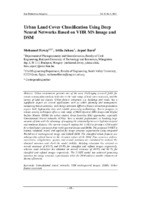Urban Land Cover Classification Using Deep Neural Networks Based on VHR MS Image and DSM

View/
Metadata
Show full item record
URI
Collections
Abstract
Urban environment presents one of the most challenging research fields for
remote sensing data analysis tasks due to the wide range of land cover materials, and the
variety of land use classes. Urban feature extraction, e.g. buildings and roads, has a
significant impact on several applications such as urban planning and management,
monitoring human activities, and change detection. Effective feature extraction procedures
require both high-quality data and reliable processing methodology. Recent progress in
remote sensing techniques offers a wide range of Multi-Spectral (MS) images and Digital
Surface Models (DSMs) for urban studies. Deep Learning (DL) approaches, especially
Convolutional Neural networks (CNNs), have a notable performance in handling large
amounts of data with the advantage of mapping the relationship between high-dimensional
and nonlinear features. The current research employs the U-NET to develop a CNN model
for urban feature extraction from multi-spectral images and DSMs. The proposed U-NET is
trained, validated, tested, and applied for image semantic segmentation using integrated
WorldView-2 multi-spectral image and LiDAR DSM. The classified urban features are
subsequently refined based on the elevation values of the DSM. Four accuracy indices:
correctness, completeness, quality, and overall accuracy are calculated to evaluate the
obtained outcomes and check the model stability. Building extraction has attained an
overall accuracy of 69.1% and 89.9% for classified and refined images respectively,
whereas road extraction has obtained an overall accuracy of 89.9% and 90.7% for
classified and refined images respectively. The U-NET model has achieved promising
outcomes for image semantic segmentation, while the DSM added a notable enhancement
during refinement.
- Title
- Urban Land Cover Classification Using Deep Neural Networks Based on VHR MS Image and DSM
- Author
- Fawzy, Mohamed
- Juhasz, Attila
- Barsi, Arpad
- xmlui.dri2xhtml.METS-1.0.item-date-issued
- 2025
- xmlui.dri2xhtml.METS-1.0.item-rights-access
- Open access
- xmlui.dri2xhtml.METS-1.0.item-identifier-issn
- 1785-8860
- xmlui.dri2xhtml.METS-1.0.item-language
- en
- xmlui.dri2xhtml.METS-1.0.item-format-page
- 21 p.
- xmlui.dri2xhtml.METS-1.0.item-subject-oszkar
- convolutional neural networks, VHR multi-spectral images, DSMs, urban feature extraction
- xmlui.dri2xhtml.METS-1.0.item-description-version
- Kiadói változat
- xmlui.dri2xhtml.METS-1.0.item-identifiers
- DOI: 10.12700/APH.22.8.2025.8.8
- xmlui.dri2xhtml.METS-1.0.item-other-containerTitle
- Acta Polytechnica Hungarica
- xmlui.dri2xhtml.METS-1.0.item-other-containerPeriodicalYear
- 2025
- xmlui.dri2xhtml.METS-1.0.item-other-containerPeriodicalVolume
- 22. évf.
- xmlui.dri2xhtml.METS-1.0.item-other-containerPeriodicalNumber
- 8. sz.
- xmlui.dri2xhtml.METS-1.0.item-type-type
- Tudományos cikk
- xmlui.dri2xhtml.METS-1.0.item-subject-area
- Műszaki tudományok - multidiszciplináris műszaki tudományok
- xmlui.dri2xhtml.METS-1.0.item-publisher-university
- Óbudai Egyetem
